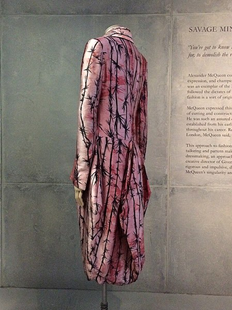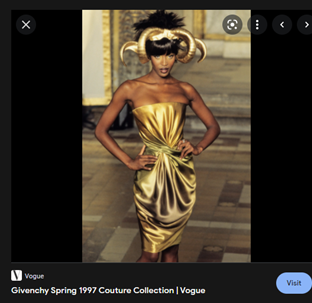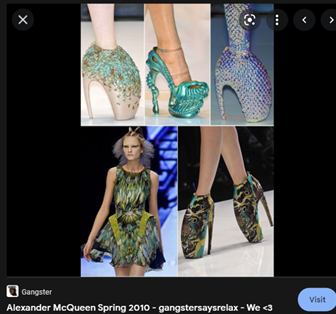A designer’s backstory: Alexander McQueen
McQueen’s upbringing, the inspiration behind some of his most famous collections, and details about his unfortunate death.

Screenshot taken by Brandon Portillo, from Discover Hollywood
Poster from the 2018 documentary titled “McQueen”

February 11th, 2010 was the day the world lost an incredible talent: Alexander McQueen took his own life after years of battling issues of mental health, substance abuse, and facing tragedy.
Over a decade after his death, many have sidelined his artistry and the impact he had on fashion in the 90’s and early 2000’s, and simply reduced him to a pair of chunky sneakers. Despite his remaining a legend in the fashion world, many people, especially those from the younger generation, may not be totally familiar with his work. He had a very interesting career arc that unfortunately ended too soon. His life is inspiring as well as tragic, and tells an important story of passion, drive, and how some of the most creative people are tortured by their own darkness and past.
In this A Designer’s Backstory, we’ll be taking a close look at the life and career of L.A. McQueen.
Lee Alexander McQueen was born on March 17th, 1969, in London, England to Ronald and Joyce McQueen, he was the youngest of 6 children. He came from a relatively well-off family, with all of his basic human needs met. Growing up he had some trouble in school, having difficulty concentrating and dealing with bullying, he was often teased by classmates for his homosexuality and would spend time drawing clothes on his notebooks. At 16 he left school and, after knocking on their door, became an apprentice at Anderson and Sheppard, a tailoring company located in Savile Row, London. He started out padding collars, putting in pockets, making pants and jackets, learning to make the clothes fit like a glove.

Despite excelling, he did not like the environment, but he discovered a true passion for making clothes, especially jackets and trousers. He then found a job at Red or Dead, a young street-wear company. The brand’s Space Baby marked a before and after in his creative development, this was when he first discovered it was acceptable to take events or concepts and make a visual representation of them through fashion. He had a true passion for making clothes and, after a brief time in Milan working for designer Romeo Gigli, went to Central Saint Martin’s College of Art and Design and majored in Fashion design. The end project of the course was a fashion show, and it was the first time he was introduced to the world.
His graduation collection was entitled “Jack the ripper stalks his victims”, inspired by the serial killer’s Whitechapel victims of 1888. It was a very interesting collection. Locks of hair were sewn into the clothing, in reference to the Victorian era when prostitutes would sell their hair. In fact, in the early years of his career he did not have a logo, he instead, he would put locks of hair inside a plastic pouch and use that as the logo in all of his pieces.
The entire collection was bought by Isabella Blow, a fashion editor for a British magazine. In an old recording included in a documentary about Lee titled “McQueen”, Blow stated, ” They were modern, they were classical. He would do a black coat and he’d line it with human hair. It was bloody red! It was like a body, it was like flesh with blood. It was about sabotage and tradition, which is the perfect combination of beauty and violence, all the things I suppose the 90’s represent.” Isabelle would take in Lee as his protégé, and became a very close friend of his. Many people credited her as discovering Alexander and being the cause of his fame.

His next fashion show was quite controversial, and was one of the many times throughout his career where he would be accused of being a misogynist.
The show was titled “Highland Rape,” the inspiration behind this show came from his mother. She adored history and was very interested in the genealogy of their family, she wanted to prove that they came from the McQueen’s of the isle of Skye. She would often tell stories regarding the Highland clearances of the 18th and 19th century. There was lots of violence, murder, and also abuse against women during this time. Lee took inspiration from this and decided to create a collection about “England’s rape of Scotland”.
Lee also had a past of being sexually abused by his brother-in-law, which had an impact on the creation of the infamous collection.
The show featured women with ripped garments and messy hair. Many people claim it looked like something straight out of a crime scene. Critics and media accused him of hating women and not respecting the models involved. However, he made every single headline, which was his goal: to create buzz.

McQueen’s influence and fame was growing, and in 1996 he was appointed creative director at Givenchy, which marked yet another turning point in his creative development. His team created a 55-look collection in 25 days, it was titled Search for the Golden Fleece. It consisted of garments only in white and gold and some of the accessories included horns and butterfly wings.
Some of the pieces were pretty risky in comparison to the previous collections of Givenchy, and the media did not necessarily take it well. There was a lot of backlash from French critics, arguing that he wasn’t a good choice for the creative director of the brand and that the garments were a failure. The media judged him harshly because of his artistry and physical appearance. In an interview included in the previously mentioned documentary, he stated, “I saw myself within the public eye as the gazelle, and the gazelle always got eaten. That’s how I see human life, we can all be discarded quite easily. The fragility of a designer’s time in the press, it’s a jungle out there.”
Lee worked for Givenchy from 1996-2001, during this time he traveled between Paris and London and managed both Givenchy and his own line. He was under an extraordinary amount of pressure, as he was creating from 10-14 collections a year. Around this time was when his affair with illegal substances started. He said that cocaine made him see everything in a clearer and more honest manner, yet he recognized he wouldn’t recommend it to anyone. He became a very hard person to work with at times, and very paranoid. He thought the whole world was out to get him, this hard difficult work rhythm took a toll on his mental health and relationship with family, friends, and his own work. Some of the friends that had stuck by his side since the beginning left due to how demanding and unpleasing the job became.
The first collection released by the brand Alexander McQueen since he joined Givenchy was entitled “It’s a jungle out there”. As previously stated above, the Scottish designer deeply felt how designers like him were seen as prey by the public eye. The inspiration behind the collection was the ephemerality of creatives and the way the media judges them. It truly is a jungle out there. People were shocked by the presentation of this line, as the hair and makeup was different from anything seen before. It was big, exaggerated and all the models looked like animals. During the show, students that had not been allowed in stormed the barricade and kicked fire pots present in the scene.

There were crashed cars in the catwalk that had not been emptied of gasoline, and they caught on fire. There were literally cars on fire in the runway, however, Lee refused to stop the show, and told the workers and models to keep going out. Despite this incredibly dangerous decision, the show went on smoothly and many of the people present believed the fire was planned.
McQueen’s time at Givenchy was at times very frustrating in terms of budget, but he always understood both the need for creative and financial responsibility he had on his shoulders w the brand. Financial concerns were also part of his own brand, but in December 2000 he made a deal with the Gucci group, in which they acquired 51% of Alexander McQueen. He still remained the creative director, this allowed for him to be fully creative and have more funding without having to worry about how the sells of a particular collection would affect his ability to continue creating.
His last collection shown publicly was titled Plato’s Atlantis, which was shown in Paris on October 6, 2009. This collection was meant to illustrate some of the worlds Lee imagined in his head, which couldn’t be explained through words. The inspiration behind it was his love for scuba diving and swimming, as well as the feeling of relief being submerged under water provided him. The show was one of the first fashion shows to be transmitted live, as we were nearing a new digital age, although the transmission did not go as smoothly as planned. The garments consisted of endless printed designs. They could be from fish fins or snake scales, all edited into a unique pattern which would be printed onto clothes. The show was incredibly well-received, but one of the notable pieces are the famous “Armadillo shoes,” although they may not look particularly comfortable, their unique style is what makes them so captivating.

Despite all the fame and success, at his core, Lee was a very lonely person. His past shaped his creativity but also tortured him, it had him stuck to certain behaviors that ended up destroying his life.
In his last years, he underwent many tragedies that, little by little, led to his choice to stop living. For starters, his best friend Isabella Blow died by swallowing poison when he was diagnosed with HIV. As if these news weren’t devastating enough already, his mother had to go through dialysis and was very weak in her last few months. Lee was not ready to accept the fact that she was going to die, and when she did, it shattered his world. His sister Janet stated in the 2018 documentary, “I think that perhaps after my mom went, he felt there was nothing that could make him happy anymore. I just think… that it was in that moment that he had that emptiness.”
Lee Alexander McQueen hanged himself on the eve of his mother’s funeral. He died a mastermind, a creative genius, and a beloved storyteller. His impact on fashion should not be forgotten, and it teaches important lessons about how fashion can be used as a medium to express stories and feelings. Truly McQueen was a legend gone too soon.



